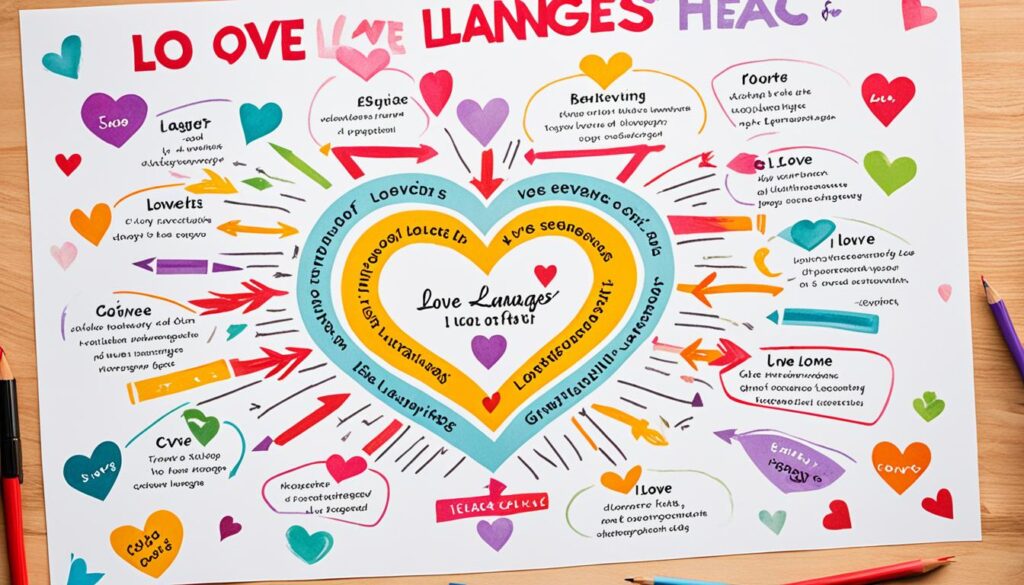Relationships need emotional connection to thrive. Knowing how your partner likes to give and receive love can change everything. Gary Chapman, an author and pastor, came up with the idea of “love languages.” He found five main ways people show and feel love: words of affirmation, quality time, physical touch, acts of service, and receiving gifts.
Learning what your partner’s love language is can make your bond stronger. It helps improve how you talk to each other and builds a deeper connection. This makes your relationship more intimate.
Chapman’s theory says everyone has a special way of feeling loved. Once you know your partner’s, you can show them love in ways they understand best. This makes your relationship better.
Knowing your own love language helps you tell your partner what you need. This leads to a happier relationship for both of you.
What are the 5 Love Languages?
Learning about the five love languages can change how you connect with others. Dr. Gary Chapman says in his book “The 5 Love Languages” that everyone has a main way of feeling and showing love. Knowing how to speak your partner’s language can make your relationship better.
Words of Affirmation
People who love words of affirmation feel loved when you say nice things, praise them, and write love notes. Words of affirmation are a strong way to show you care and value them.
Quality Time
Quality time lovers want to spend time with you where you’re fully there for each other. It’s not just about being together. It’s about being fully present and focused on each other.
Acts of Service
Those who prefer acts of service feel loved when you help them out. This can be doing chores, running errands, or anything that makes life easier for them. These acts show you care deeply.
Receiving Gifts
For those who love getting gifts, it’s the thought that counts, not the price. Gifts show you’re thinking about them and care. They’re a way to express your love in a physical way.
Physical Touch
Physical touch lovers feel loved through hugs, holding hands, cuddling, or even a simple pat on the back. Touch creates a sense of safety and closeness in a relationship.
Understanding and speaking each other’s love languages can deepen your emotional connection. It makes your relationship better overall.

The Theory Behind Love Languages
Dr. Gary Chapman, a relationship expert and author, created the love languages concept. He noticed couples often didn’t understand each other’s emotional needs. He found five main love languages: words of affirmation, quality time, acts of service, receiving gifts, and physical touch.
Chapman’s theory says knowing your and your partner’s love language helps meet emotional needs. When you speak your partner’s language, they feel loved and understood. This can make your relationship closer and more intimate.
His book, “The 5 Love Languages: The Secret to Love That Lasts,” has sold over 20 million copies worldwide. It’s been translated into 49 languages. But, some studies question the theory’s reliability and validity. They found little proof that matching love languages makes relationships happier.
Still, many people find the love languages idea helpful. Personal stories often show people prefer certain ways of showing and getting love. More research is needed to fully grasp the love languages theory. Yet, it’s a useful tool for better communication in relationships.

Love languages explained
Understanding love can be complex, but knowing the love language explanation helps a lot. Dr. Gary Chapman introduced the idea of love languages. These languages show how people express and receive love. Let’s look at the main love languages and how they can make relationships better.
Words of Affirmation
People with the words of affirmation love language love hearing kind words. They enjoy compliments and reassurance from their partner. These words make them feel important and close.
Quality Time
Those with the quality time love language value being fully focused on by their partner. They feel loved when their partner gives them their full attention. This means doing things together or just being there without distractions.
Acts of Service
For people with the acts of service love language, doing helpful tasks shows love. It could be cooking, cleaning, or helping with a project. These actions show they care and want to help.
Learning about these love languages helps couples speak each other’s language. This leads to a stronger connection and a happier relationship.
Identifying Your Love Language
Finding out your main love language is key to knowing how you show and receive love. This knowledge can greatly improve your relationship communication and boost your self-awareness in your relationships.
Think about how you naturally show love to others and what makes you feel most loved. Consider what you often ask for or complain about in your relationships. Also, think about how you show love to your partner. The love language that feels most natural to you is probably your main way of giving and getting affection.
- Words of Affirmation: Do you love getting compliments, words of encouragement, and thanks?
- Quality Time: Do you feel most loved when your partner gives you their full attention?
- Acts of Service: Do you value it when your partner helps out with tasks and chores?
- Receiving Gifts: Do you feel special when your partner surprises you with gifts?
- Physical Touch: Do you find comfort and connection through hugs, cuddles, or holding hands?
By identifying your love language, you can understand better how to share your needs and value how your partner shows love. This self-awareness is key to creating stronger, more rewarding relationship communication.
The Benefits of Understanding Love Languages
Exploring love languages can change your relationships for the better. When you know your and your partner’s love languages, you get key insights. These insights help you communicate, empathize, and connect more deeply.
Improved Communication
Learning about love languages changes how you talk to each other. You learn how your partner likes to give and receive love. This way, you can make sure they feel heard and valued.
Increased Empathy
Love languages teach you to see things from your partner’s point of view. You learn what makes them feel loved. This makes you more caring and understanding in your relationship.
Deeper Intimacy
Using each other’s love languages builds a strong connection. When you show love in ways your partner likes, you show you care about their feelings. This makes your relationship stronger and more rewarding.
Understanding love languages is key to better communication, empathy, and closeness in relationships. With this knowledge, you can build a lasting, meaningful bond with your partner.
Love Languages in Different Relationships
The idea of love languages is often linked to romantic relationships. But, it’s also useful for understanding and improving family, friend, and work relationships. It’s about seeing how people like to give and receive love. Then, try to speak their love language.
In family ties, parents can meet their kids’ emotional needs by learning their love languages. For example, a child who loves Words of Affirmation feels special with praise. A child who values Quality Time feels loved through focused time together. Adult children can show their love by using their parents’ love languages too.
Friends can also gain from knowing love languages. By seeing how your friends like to show and receive love, you can connect better. A friend who likes Acts of Service will value your help. A friend who loves Receiving Gifts will feel special with a thoughtful gift.
Even at work, love languages can make a difference. Coworkers who love Words of Affirmation enjoy positive feedback. Those who prefer Quality Time like one-on-one meetings and team activities.
| Relationship Type | Potential Love Language Expressions |
|---|---|
| Family |
|
| Friendships |
|
| Coworkers |
|
Understanding and using the five love languages in different relationships can build stronger bonds. It improves communication and deepens understanding. Tailoring how you show love to each person’s language can make relationships more meaningful and rewarding across all life areas.
Limitations of Love Languages
The love languages framework can help improve how we talk and connect in relationships. But, it’s not perfect and has some downsides. One issue is getting too competitive about using your partner’s love language.
Some people might focus too much on “winning” at love languages. They might try to make sure their needs are met more than their partner’s. This can make the relationship tense and unbalanced. Also, love languages don’t fix all relationship problems.
Avoiding Competitiveness
To dodge competitiveness, couples should work together and understand each other. Remember, the aim is to connect and meet each other’s emotional needs, not to score points. Focusing on the quality of our actions and giving love can make using love languages healthy.
Not a Cure-All for Relationship Issues
Love languages can be useful, but they’re not a fix for everything. Issues like trust, communication, or big differences might need more work or counseling. Love languages are just one tool, and combining them with other strategies works best.
Understanding the limits of love languages shows the need for a balanced approach to relationships. By seeing love languages as part of a bigger relationship plan, couples can use them well and avoid their downsides.
Practicing Love Languages in Your Relationship
Once you and your partner know your love languages, it’s time to use them. Adding your partner’s main love language to your relationship can make communication better. It can also make you both feel more loved and valued.
Gift Ideas
For those who love receiving gifts, thoughtful presents are a great way to show you care. Think about gifts that match their interests or hobbies. Small things like a handwritten note or a homemade treat can mean a lot.
Acts of Service Suggestions
If your partner’s love language is acts of service, helping them out can mean a lot. This could be doing chores, running errands, or finishing a project they’ve been putting off. It shows you care and are there to support them.
Quality Time Activities
For those who love quality time, making time to be together is key. This could be just talking without interruptions, doing a hobby together, or a special date night. The focus should be on the quality of your time together, not just how much time you spend.
| Love Language | Gift Ideas | Acts of Service | Quality Time Activities |
|---|---|---|---|
| Words of Affirmation | Personalized cards, love notes, or heartfelt compliments | Offering encouragement and verbal appreciation | Engaging in deep, meaningful conversations |
| Quality Time | Experiences or activities that allow for undivided attention | Scheduling uninterrupted time together | Enjoying leisure activities or shared hobbies |
| Acts of Service | Helping with household chores or tasks | Offering to assist with errands or projects | Engaging in collaborative activities or problem-solving |
| Receiving Gifts | Thoughtful, personalized gifts that reflect your partner’s interests | Offering to help with gift-giving for special occasions | Sharing experiences or creating memories together |
| Physical Touch | Sensual or intimate gifts, such as massage oils or lingerie | Offering gentle hugs, hand-holding, or other physical gestures | Engaging in physical intimacy and affectionate activities |
Understanding and using your partner’s love languages can make your relationship better. It helps meet each other’s emotional needs. The goal is to find ways to show love that your partner values most, making your bond stronger.
Self-Care and Love Languages
Relationship expert Gary Chapman’s love languages idea also fits with self-care and self-love. Knowing your love language helps you find special ways to care for yourself deeply.
If your love language is words of affirmation, speak kind words to yourself often. If it’s physical touch, treat yourself to massages or relaxing activities that feel good.
Using your love language in self-care meets your emotional needs and builds self-love. It could be spending time alone, making your life easier, or enjoying gifts. Matching your self-care with your love language makes it more rewarding and fulfilling.
| Love Language | Self-Care Ideas |
|---|---|
| Words of Affirmation | Write affirming notes to yourself, keep a self-love journal |
| Quality Time | Engage in introspective activities, practice mindfulness meditation |
| Physical Touch | Schedule regular massages, take a relaxing bath, practice self-massage |
| Receiving Gifts | Treat yourself to a special self-care purchase, create a self-care kit |
| Acts of Service | Outsource chores, delegate tasks, or automate routines to free up time |
Understanding your love language and adding it to your self-care routine can deepen self-love. It lets you enjoy self-care that meets your emotional needs. This can start a journey of self-discovery and better wellbeing.
Love Languages in Non-Romantic Relationships
Love languages aren’t just for romantic partners. They also help in family, friend, and work relationships. Knowing how to speak each other’s love languages can make these bonds stronger. It helps in expressing appreciation and improving communication.
Using love languages in non-romantic settings lets us tailor our interactions. For example, spending quality time with a friend who values it can make them feel special. On the other hand, helping a family member with chores shows them you care.
At work, knowing a coworker’s love language can make the office better. Saying thank you or giving a small gift can boost someone’s morale. It shows they’re valued and noticed.
| Relationship Type | Applying Love Languages | Potential Benefits |
|---|---|---|
| Family | Identify and cater to each family member’s primary love language, such as quality time for children, acts of service for aging parents, and words of affirmation for siblings. | Strengthened familial bonds, improved communication, and a greater sense of belonging and support. |
| Friendships | Understand how your friends prefer to receive and give love, and adjust your interactions accordingly, such as being physically present (physical touch) or thoughtfully planning activities (quality time). | Deeper, more fulfilling friendships, increased empathy, and a stronger sense of connection. |
| Coworkers | Observe how your colleagues respond to various forms of appreciation and recognition, and tailor your interactions to their love language preferences, such as public praise (words of affirmation) or personal gestures (receiving gifts). | Improved teamwork, enhanced job satisfaction, and a more positive and collaborative work environment. |
Applying love languages in our non-romantic relationships helps us connect deeper. It makes our support systems stronger and interactions more meaningful. Whether it’s with family, friends, or coworkers, knowing and using their love languages can build better relationships.
Conclusion
Dr. Gary Chapman’s love languages idea has changed how we see and improve our relationships. It teaches us to use our main love language to show and get love better. This can be through words, spending time together, helping each other, giving gifts, or physical touch.
Some people have criticized the love languages theory. Yet, it’s still a key way to better communicate, understand each other, and make our relationships deeper. Making an effort to use each other’s love languages is important. It helps everyone feel more loved and satisfied.
In wrapping up our look at love languages, remember it’s key to know how you and your partner like to show and receive love. Being open to learn and use each other’s languages is crucial. This approach helps build lasting, strong relationships.
FAQ
What are the five love languages?
The five love languages are words of affirmation, quality time, acts of service, receiving gifts, and physical touch.
What is the purpose of understanding love languages?
Understanding love languages helps improve communication and empathy. It leads to deeper intimacy by teaching how to express love in ways your partner gets.
How can I identify my own love language?
Think about how you show love to others and what makes you feel loved. Consider what you ask for or complain about in your relationships. Also, think about how you show love to your partner.
Can love languages be applied to non-romantic relationships?
Yes, love languages work in relationships between parents and kids, friends, family, and coworkers. Watch how people in your life give and receive love. Then, try to communicate in their love language.
What are the limitations of the love languages concept?
The love languages might make you compete over using a partner’s language. They’re not a fix for all relationship issues. Use them as one tool to better communicate and connect.

